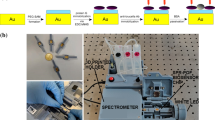Abstract
Polyclonal antibodies against Escherichia coli and fluorescent, secondary, antibodies were immobilized on borosilicate glass fibers pre-treated with 3-glycidyloxypropyl trimethoxysilane (GPS). Light with an average wavelength of 627 nm, emitted by a diode placed at one end of the glass fiber, was detected by an ultrasensitive photodiode with peak sensitivity at 640 nm. Changes in fluorescence, caused by binding of E. coli to the antibodies, changed the net refractive index of the glass fiber and thus the internal reflection of light. These evanescent changes in photon energy were recorded by an ultrasensitive photodiode. Signals were amplified and changes in voltage recorded with a digital multimeter. A linear increase in voltage readings was recorded over 2 h when 3.0 × 107 CFU/ml and 2.77 × 109 CFU/ml E. coli were adhered to the antibodies. Voltage readings were recorded with E. coli cell numbers from 2 × 103 CFU/ml to 2 × 106 CFU/ml, but readings remained unchanged for 2 h, indicating that the limit of detection is 3.0 × 107 CFU/ml. This simple technology may be used to develop a low-cost, portable, fiber-optic biosensor to detect E. coli in infections and may have applications in the medical field. Research is in progress to optimize the sensitivity of the fiber-optic biosensor and determine its specificity.





Similar content being viewed by others
References
Bharadwaj R, Sai V, Dhawangale KTA, Kundu T, Titus S, Verma PK, Mukherji S (2011) Evanescent wave absorbance based fiber optic biosensor for label-free detection of E. coli at 280 nm wavelength. Biosens Bioelectron 26(3367–3370):1
Bosch ME, Sánchez AJR, Rojas FS, Ojeda CB (2007) Recent development in optical fiber biosensors. Sensors 7(797–859):2
Chambers JP, Arulanandam BP, Matta LL, Weis A, Valdes JJ (2008) Biosensor recognition elements. Curr Issues Mol Biol 10(1–12):3
Corso C, Dickherber A, Hunt W (2008) An investigations of antibody immobilization methods employing organosilanes on planar ZnO surfaces for biosensor applications. Biosens Bioelectron 24(805–811):4
DeMarco D, Lim D (2002) Detection of Escherichia coli O157:H7 in 10- and 25-gram ground beef samples with an evanescent-wave biosensor with silica and polystyrene waveguides. J Food Prot 65(596–602):5
Hunt HK, Armani AM (2010) Label-free biological and chemical sensors. Nanoscale 2(1544–1559):6
Ivnitski D, Abdel-Hamid I, Atanasov P, Wilkins E (1999) Biosensors for detection of pathogenic bacteria. Biosens Bioelectron 14(599–624):7
Kim P, Kohli N, Hassler B, Dotson N, Mason A, Worden RM, Ofoli R (2003) An electrochemical interface for integrated biosensors. Proc IEEE 2(1036–1040):8
Kuswandi B, Nuriman, Huskens J, Verboom W (2007) Optical sensing systems for microfluidic devices: a review. Anal Chim Acta 601(141–155):9
Lazcka O, Del Campo FJ, Muñoz FX (2007) Pathogen detection: a perspective of traditional methods and biosensors. Biosens Bioelectron 22(1205–1217):10
Leung A, Shankar PM, Mutharasan R (2007) A review of fiber-optic biosensors. Sens Actuators, B 125(688–703):11
Luo X, Davis JJ (2013) Electrical biosensors and the label free detection of protein disease biomarkers. Chem Soc Rev 42(5944–5962):12
Madappa T (2017) Escherichia coli infections, Medscape, http://emedicine.medscape.com/article/217485-overview. Accessed on July 2017)
McGraw SK, Anderson MJ, Alocilja EC, Marek PJ, Senecal KJ, Senecal AG (2011) Antibody immobilization on conductive polymer coated nonwoven fibers for biosensors. Sens Transducers 13(142–149):9n
Monk DJ, Walt DR (2004) Optical fiber-based biosensors. Anal Bioanal Chem 379(931–945):13
Mura S, Greppi G, Marongiu ML, Roggero PP, Ravindranath SP, Mauer LJ, Schibeci N, Perria F, Piccinini M, Innocenzi P, Irudayaraj J (2012) FTIR nanobiosensors for Escherichia coli detection. Beilstein J Nanotechnol 3:485–492
Ohk S-H, Bhunia AK (2013) Multiplex fiber optic biosensor for detection of Listeria monocytogenes, Escherichia coli O157:H7 and Salmonella enterica from ready-to-eat meat samples. Food Microbiol 33(166–171):14
Queiros RB, Noronha J, Marques P, Sales MGF (2012) Emerging (bio)sensing technology for assessing and monitoring freshwater contamination—methods and applications. In: Voudouris D (ed) Ecological water quality—water treatment and reuse, vol 15. InTech, Rijeka, pp 65–94
Rijal K, Leung A, Shankar PM, Mutharasan R (2005) Detection of pathogen Escherichia coli O157:H7 at 70 cells/mL using antibody-immobilized biconical tapered fiber sensors. Biosens Bioelectron 21(871–880):16
Strehlitz B, Nikolaus N, Stoltenburg R (2008) Protein detection with aptamer biosensors. Sensors 8(4296–4307):10n
Thévenot DR, Toth K, Durst RA, Wilson GS (1999) Electrochemical biosensors: recommended definition and classification. International Union of Pure and Applied Chemistry 17
Trojanowicz M (2001) Miniaturized biochemical sensing devices based on planar bilayer lipid membranes. Fresenius J Anal Chem 371(246–260):18
Vo-Dinh T, Cullum B (2000) Biosensors and biochips: advances in biological and medical diagnostics. Fresenius J Anal Chem 366(540–551):19
Werber D, Krause G, Frank C, Fruth A, Flieger A, Mielke M, Schaade L, Stark K (2012) Outbreaks of virulent diarrheagenic Escherichia coli—are we in control? BMC Medicine 10:11. http://www.biomedcentral.com/1741-7015/10/11
Acknowledgements
The National Research Foundation of South Africa (Grant Number CPRR13090533029) for funding and Glasschem CC, Stellenbosch, South Africa, for providing the optical fibers and assisting in the manufacturing process.
Author information
Authors and Affiliations
Corresponding author
Rights and permissions
About this article
Cite this article
Maas, M.B., Maybery, G.H.C., Perold, W.J. et al. Borosilicate Glass Fiber-Optic Biosensor for the Detection of Escherichia coli . Curr Microbiol 75, 150–155 (2018). https://doi.org/10.1007/s00284-017-1359-y
Received:
Accepted:
Published:
Issue Date:
DOI: https://doi.org/10.1007/s00284-017-1359-y




